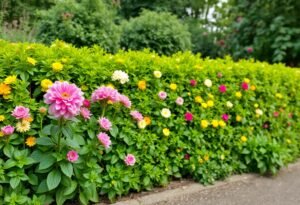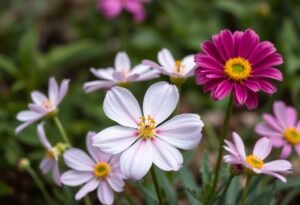Leafy Beauties
A large group of plants that perfectly adapt to shady conditions features those with lush, decorative leaves. Hostas, often referred to as plantain lilies, are among the most popular choices for shaded areas. Their striking, curled leaves come in a variety of green shades and patterns, adding charm to any garden. Another fantastic choice is heucheras, which enchant with colorful foliage in hues of red, orange, and yellow. With such a diversity of shapes and colors, fantastic compositions can be easily created.
Blooming Wonders
Shady corners can also successfully host flowering plants. Brunnera, commonly known as false forget-me-not, is a small plant that bursts into blue flowers in spring, bringing a breath of freshness to the garden. We should also consider red poppies, which thrive in shade and can add vibrant colors even to the most somber spots.
Decorative Plants
Don’t forget about the decorative plants that also thrive in the shade. Ferns are one of the most popular houseplants, well known for their ability to flourish in darker environments. Their delicate, green fronds bring tranquility and harmony to interiors. We might also consider introducing schefflera – a plant with large, glossy leaves that adds an exotic touch to our living spaces.
Diverse Native Plants
It’s also worth noting the surprising diversity among shade-loving plants. Astilbe not only boasts stunning flowers but also has exquisite, feathery foliage. Flowers in shades of pink, white, and red add vibrancy to even the dimmest garden corners. Aquilegia, featuring unique, cascading blooms, is another stunning option that dazzles with its beauty.
Herbs for Every Garden
Herbs represent another family of plants that can thrive in the shade. Peppermint and basil are perfect examples that can be grown in less sunny spots. They can be easily cultivated in pots or directly in the ground, and their fresh aroma will surely enhance any dish they accompany.
Creative Compositions Ahead
Creating compositions with shade-loving plants offers endless possibilities. You can combine various types of foliage, shapes, and flower colors. Designing a small garden with plants that promote harmony and relaxation is a wonderful way to utilize shaded spots. I encourage you to experiment and create unique arrangements that will delight the eyes all year round.
Conclusion
Shade-loving plants can bring immense charm to our gardens, even in places that seem unreachable by sunlight. By selecting the right plants, we can create an environment that captivates with its beauty. A shade garden is not a hindrance; it’s an opportunity to discover the extraordinary world of vegetation.
Disclaimer
This article is for informational purposes only and does not substitute for professional gardening advice. It’s always wise to consult an expert before making decisions about planting.

















